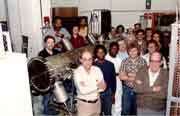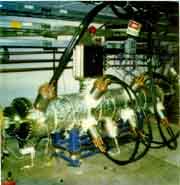Photos of the Accumulator Shuttered Kicker Larry Bartoszek worked on at FermilabA kicker magnet is one that gives a beam of charged particles being injected from a beam transport line to an accelerator ring a final "course adjustment" or "kick" that aligns the incoming beam with the orbit of the accelerator it is going into. (Kickers are also used to give beams already in accelerators their first kick out for extraction to experimental area beam transport lines.) There are many types of kickers at Fermilab, but the Accumulator Shuttered Injection Kickers were the first of their kind at Fermilab. Only at CERN for the ISR had injection kickers of this type been built before in the world. These shuttered kickers differ greatly from the ISR kickers because of the difference between the timing of the injection and stacking cycles of the two machines. The ISR shuttered kickers had to open and close in less than 100 milliseconds. Fermilab shuttered kickers open and close on a sinusoidal cycle 2 seconds long. What makes shuttered kickers different from the usual kicker is the shutter. The shutter is a long thin blade of metal which prevents the particles already stored ("stacked") in a storage ring accelerator (Fermilab's Accumulator or CERN'S ISR) from feeling the magnetic kick of the kicker magnet when it fires to deflect the injected (or extracted) beam. The shutter dissipates the energy of the kicker magnet by allowing eddy currents to circulate in the metal of the shutter, which protects the stacked beam. The shutter then needs to get out of the space between the stacked and injected beams so that the injected beam can cross the gap between the orbits as it is stochastically cooled. The design concept for the final Fermi shutter mechanism was suggested by Alain Poncet of CERN. Larry Bartoszek did the final mechanical engineering and design of this concept (after developing an alternative fast shutter that was not used.) Ed Tilles and George Termansen of Fermilab did the mechanical design of the magnet, vacuum vessel, and support stand. Jeff Petter of Fermilab (now Dyna-Power) did the electrical design for the kicker magnet. Photos are courtesy of Fermilab Media Services. (Presentation of photos from Fermilab does not imply endorsement of any product or service.) You are welcome to download any of the images. If they are used for other than private viewing, credit to Bartoszek Engineering and Fermilab would be appreciated.
This device was a test fixture to fatigue life test different metal bellows for the shutter application. The four bar linkage mechanism that drives the shutter is mocked up at both ends of this device to create exactly the same motion on the bellows that the actual shutter mechanism produces. A bellows is needed to feed the mechanical motion of the shutter drive mechanism into the vacuum vessel that the shutter moves in. We wanted to use hydroform stainless steel bellows for this mechanism because they are much cheaper than stainless welded bellows. Unfortunately, they were unable to resist fatigue cracking. The shutter opens and closes every 2 seconds, 24 hours a day, seven days a weeks for most of the year. Bellows replacement is difficult and failures in the beam line lead to very expensive shut downs, so fatigue life was of utmost importance. Metal welded bellows have near infinite life in this application.
This group shot was taken in the basement of Wilson Hall with all of the Fermilab staff who worked on designing, building and installing the shuttered kickers into the Antiproton Source tunnel.
This view shows some of the complexity of the structure of this type of transmission line kicker magnet. The magnet is made up of layers of capacitor plates, ceramic insulators and ferrite plates. These different materials and shapes assembled together allow the electromagnetic pulse coming from the pulse-forming network (see the thyratron page,) to propagate down the length of the magnet creating the magnetic kick that adjusts the angle of the incoming beam. Much attention was paid to surface finish on the metal high voltage capacitor plates to avoid vacuum surface discharges. The shutter is the curved shape to the right and below the center of the magnet (shutter is open). The thin sheet metal "U" shape is for impedance matching the kicker with the beam pipe on either end.
This view shows the shuttered kicker installed in the tunnel in sector 20. You can see the bundles of RG220 cables coming from the pulse-forming network which power the three separate magnet modules inside the vacuum vessel. The black box on top of the vacuum vessel is an ion pump. The whole kicker is supported on a remotely movable stand. To accomodate the motion of the kicker vessel, it is connected to the accumulator beam pipe with elliptical bellows.
Back to the Projects Main Menu
Back to the People Main Menu
Back to the Bartoszek Engineering Home Page
|



